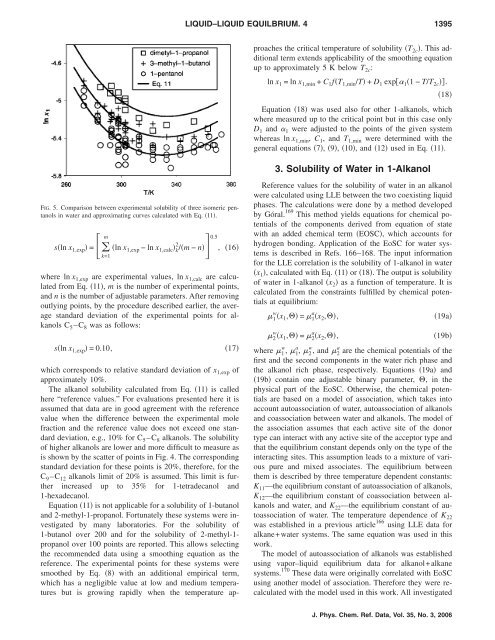Recommended Liquid–Liquid Equilibrium Data. Part 4. 1-Alkanol ...
Recommended Liquid–Liquid Equilibrium Data. Part 4. 1-Alkanol ...
Recommended Liquid–Liquid Equilibrium Data. Part 4. 1-Alkanol ...
Create successful ePaper yourself
Turn your PDF publications into a flip-book with our unique Google optimized e-Paper software.
FIG. 5. Comparison between experimental solubility of three isomeric pentanols<br />
in water and approximating curves calculated with Eq. 11.<br />
m<br />
sln x 1,exp = k=1<br />
2<br />
ln x1,exp −lnx1,calck/m − n0.5<br />
, 16<br />
where ln x 1,exp are experimental values, ln x 1,calc are calculated<br />
from Eq. 11, m is the number of experimental points,<br />
and n is the number of adjustable parameters. After removing<br />
outlying points, by the procedure described earlier, the average<br />
standard deviation of the experimental points for alkanols<br />
C 5–C 8 was as follows:<br />
sln x 1,exp = 0.10, 17<br />
which corresponds to relative standard deviation of x 1,exp of<br />
approximately 10%.<br />
The alkanol solubility calculated from Eq. 11 is called<br />
here “reference values.” For evaluations presented here it is<br />
assumed that data are in good agreement with the reference<br />
value when the difference between the experimental mole<br />
fraction and the reference value does not exceed one standard<br />
deviation, e.g., 10% for C 5–C 8 alkanols. The solubility<br />
of higher alkanols are lower and more difficult to measure as<br />
is shown by the scatter of points in Fig. <strong>4.</strong> The corresponding<br />
standard deviation for these points is 20%, therefore, for the<br />
C 9–C 12 alkanols limit of 20% is assumed. This limit is further<br />
increased up to 35% for 1-tetradecanol and<br />
1-hexadecanol.<br />
Equation 11 is not applicable for a solubility of 1-butanol<br />
and 2-methyl-1-propanol. Fortunately these systems were investigated<br />
by many laboratories. For the solubility of<br />
1-butanol over 200 and for the solubility of 2-methyl-1propanol<br />
over 100 points are reported. This allows selecting<br />
the recommended data using a smoothing equation as the<br />
reference. The experimental points for these systems were<br />
smoothed by Eq. 8 with an additional empirical term,<br />
which has a negligible value at low and medium temperatures<br />
but is growing rapidly when the temperature ap-<br />
LIQUID–LIQUID EQUILBRIUM. 4 1395<br />
proaches the critical temperature of solubility T2c. This additional<br />
term extends applicability of the smoothing equation<br />
up to approximately 5 K below T2c: ln x1 =lnx1,min + C1fT 1,min/T + D1 exp11−T/T2c. 18<br />
Equation 18 was used also for other 1-alkanols, which<br />
where measured up to the critical point but in this case only<br />
D 1 and 1 were adjusted to the points of the given system<br />
whereas ln x 1,min, C 1, and T 1,min were determined with the<br />
general equations 7, 9, 10, and 12 used in Eq. 11.<br />
3. Solubility of Water in 1-<strong>Alkanol</strong><br />
Reference values for the solubility of water in an alkanol<br />
were calculated using LLE between the two coexisting liquid<br />
phases. The calculations were done by a method developed<br />
by Góral. 169 This method yields equations for chemical potentials<br />
of the components derived from equation of state<br />
with an added chemical term EOSC, which accounts for<br />
hydrogen bonding. Application of the EoSC for water systems<br />
is described in Refs. 166–168. The input information<br />
for the LLE correlation is the solubility of 1-alkanol in water<br />
x 1, calculated with Eq. 11 or 18. The output is solubility<br />
of water in 1-alkanol x 2 as a function of temperature. It is<br />
calculated from the constraints fulfilled by chemical potentials<br />
at equilibrium:<br />
1 w x1, = 1 a x2,, 19a<br />
2 w x1, = 2 a x2,, 19b<br />
where 1 w , 1 a , 2 w , and 2 a are the chemical potentials of the<br />
first and the second components in the water rich phase and<br />
the alkanol rich phase, respectively. Equations 19a and<br />
19b contain one adjustable binary parameter, , in the<br />
physical part of the EoSC. Otherwise, the chemical potentials<br />
are based on a model of association, which takes into<br />
account autoassociation of water, autoassociation of alkanols<br />
and coassociation between water and alkanols. The model of<br />
the association assumes that each active site of the donor<br />
type can interact with any active site of the acceptor type and<br />
that the equilibrium constant depends only on the type of the<br />
interacting sites. This assumption leads to a mixture of various<br />
pure and mixed associates. The equilibrium between<br />
them is described by three temperature dependent constants:<br />
K 11—the equilibrium constant of autoassociation of alkanols,<br />
K 12—the equilibrium constant of coassociation between alkanols<br />
and water, and K 22—the equilibrium constant of autoassociation<br />
of water. The temperature dependence of K 22<br />
was established in a previous article 166 using LLE data for<br />
alkane+water systems. The same equation was used in this<br />
work.<br />
The model of autoassociation of alkanols was established<br />
using vapor–liquid equilibrium data for alkanol+alkane<br />
systems. 170 These data were originally correlated with EoSC<br />
using another model of association. Therefore they were recalculated<br />
with the model used in this work. All investigated<br />
J. Phys. Chem. Ref. <strong>Data</strong>, Vol. 35, No. 3, 2006
















